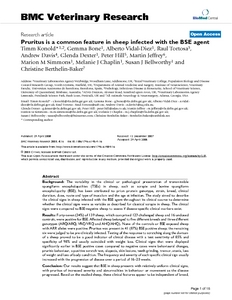Konold, T;
Bone, G;
Vidal-Diez, A;
Tortosa, R;
Davis, A;
Dexter, G;
Hill, P;
Jeffrey, M;
Simmons, MM;
Chaplin, MJ;
et al.
Konold, T; Bone, G; Vidal-Diez, A; Tortosa, R; Davis, A; Dexter, G; Hill, P; Jeffrey, M; Simmons, MM; Chaplin, MJ; Bellworthy, SJ; Berthelin-Baker, C
(2008)
Pruritus is a common feature in sheep infected with the BSE agent.
BMC Veterinary Research, 4 (16).
ISSN 1746-6148
https://doi.org/10.1186/1746-6148-4-16
SGUL Authors: Vidal-Diez, Alberto
![[img]](https://openaccess.sgul.ac.uk/100154/1.hassmallThumbnailVersion/1746-6148-4-16.pdf)  Preview |
|
["document_typename_application/pdf; charset=binary" not defined]
Published Version
Download (395kB)
| Preview
|
Abstract
BACKGROUND: The variability in the clinical or pathological presentation of transmissible spongiform encephalopathies (TSEs) in sheep, such as scrapie and bovine spongiform encephalopathy (BSE), has been attributed to prion protein genotype, strain, breed, clinical duration, dose, route and type of inoculum and the age at infection. The study aimed to describe the clinical signs in sheep infected with the BSE agent throughout its clinical course to determine whether the clinical signs were as variable as described for classical scrapie in sheep. The clinical signs were compared to BSE-negative sheep to assess if disease-specific clinical markers exist.
RESULTS: Forty-seven (34%) of 139 sheep, which comprised 123 challenged sheep and 16 undosed controls, were positive for BSE. Affected sheep belonged to five different breeds and three different genotypes (ARQ/ARQ, VRQ/VRQ and AHQ/AHQ). None of the controls or BSE exposed sheep with ARR alleles were positive. Pruritus was present in 41 (87%) BSE positive sheep; the remaining six were judged to be pre-clinically infected. Testing of the response to scratching along the dorsum of a sheep proved to be a good indicator of clinical disease with a test sensitivity of 85% and specificity of 98% and usually coincided with weight loss. Clinical signs that were displayed significantly earlier in BSE positive cases compared to negative cases were behavioural changes, pruritic behaviour, a positive scratch test, alopecia, skin lesions, teeth grinding, tremor, ataxia, loss of weight and loss of body condition. The frequency and severity of each specific clinical sign usually increased with the progression of disease over a period of 16-20 weeks.
CONCLUSION: Our results suggest that BSE in sheep presents with relatively uniform clinical signs, with pruritus of increased severity and abnormalities in behaviour or movement as the disease progressed. Based on the studied sheep, these clinical features appear to be independent of breed, affected genotype, dose, route of inoculation and whether BSE was passed into sheep from cattle or from other sheep, suggesting that the clinical phenotype of BSE is influenced by the TSE strain more than by other factors. The clinical phenotype of BSE in the genotypes and breed studied was indistinguishable from that described for classical scrapie cases.
| Item Type: |
Article
|
| Additional Information: |
PMCID: PMC2390527
© 2008 Crown; licensee BioMed Central Ltd.
This is an Open Access article distributed under the terms of the Creative Commons Attribution License (http://creativecommons.org/licenses/by/2.0), which permits unrestricted use, distribution, and reproduction in any medium, provided the original work is properly cited. |
| Keywords: |
Animals, Brain, Cattle, Encephalopathy, Bovine Spongiform, Female, Genetic Predisposition to Disease, Genotype, Male, Pruritus, Sheep, Sheep Diseases |
| SGUL Research Institute / Research Centre: |
Academic Structure > Population Health Research Institute (INPH) |
| Journal or Publication Title: |
BMC Veterinary Research |
| ISSN: |
1746-6148 |
| PubMed ID: |
18445253 |
| Web of Science ID: |
18445253 |
| Dates: |
| Date |
Event |
| 2008-04-29 |
Published |
|
  |
Download EPMC Full text (PDF)
|
 |
Download EPMC Full text (HTML)
|
 |
Go to PubMed abstract |
| URI: |
https://openaccess.sgul.ac.uk/id/eprint/100154 |
| Publisher's version: |
https://doi.org/10.1186/1746-6148-4-16 |
Statistics
Item downloaded times since 23 Aug 2012.
Actions (login required)
 |
Edit Item |




